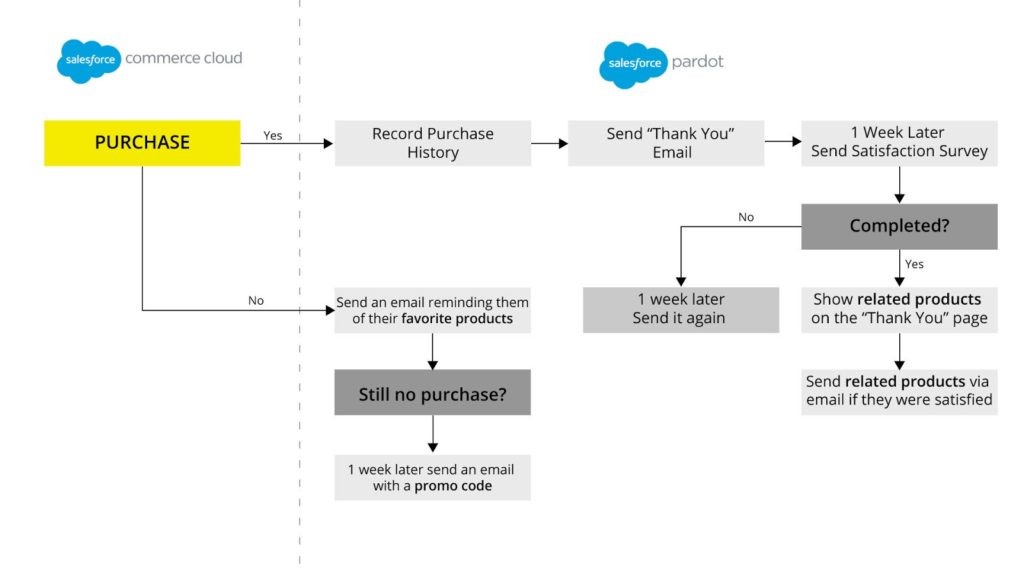Unlock the Full Potential of Pardot and Commerce Cloud
So here’s a situation that you’ve probably seen one time too many. At least I have. And in fact, you might even be the culprit here, causing this situation: A client buys an expensive, top-line system, like Salesforce’s Pardot (the specialty of our friends here at Roycon) or Salesforce Commerce Cloud (UV’s specialty). They spend small fortunes comparable to the GDPs of some really small countries just in licensing fees alone. (Okay, REALLY, REALLY small countries, like forgotten islands in the middle of the some ocean that people fight wars over but no one quite understands why anyone wants them). And then…. They, having paid a few arms and few legs in licensing fees, they… only use the most simple, superficial functionality, the sort of functionality that’s available in systems with 1% the price.
It’s like you’re paying for a Ferrari, but then you only drive it at 1 mile per hour up and down your driveway. And your friends aren’t even coming over to your house to see it because of Covid-19 so you can’t even show it off!
Knowing how common this pattern is, one recommendation that we commonly make — in fact, any consultant worth their salt should — is to use the right tool for the job. No bigger, no smaller. (There are footnote exceptions: you may want to bet you will need the bigger tool tomorrow, even if you don’t need it today, for example, so in that case, if you expect the bigger tool immediately, then perhaps the “overkill” may not be “overkill” after all.) In general, though: you swat a fly with a fly-swatter; swatting a fly with a bazooka causes more damage than it solves.
So, this leads to a question: how come more teams don’t use to their full potential these amazing weapons they already have already paid a lot of money to put into their arsenal?
The answer, my virtual friends, is largely a lack of creativity, accentuated by incentive structures for too many consultants to not be creative. (Another part of the answer is the differing incentives between Those Who Buy and Those Who Implement, but we’ll address those in another article.) In other words, in general, to use the full power of Pardot and Salesforce Commerce Cloud, you actually need some creative ideas on what you can make happen. And creative ideas are shockingly uncommon, shockingly too far and between.
But fear not! Alas, UV and Roycon are here to help! We have the technical chops and the creativity needed to actually make the most of both installs.
The first step in the formula: Salesforce Commerce Cloud and Pardot really compliment each other very well. They are opposite sides of the same puzzle, so the first step is to start with both. As the image here shows, Commerce Cloud does some parts — like that which interacts with the core commerce system — and Pardot does other parts of it — like those annoying abandoned cart emails you sometimes get.

Okay, any tech shop can set these up. But now let’s come up with some creative ways to integrate and use them — the sort of campaigns that use both to their fullest firepower; that would give you the best of both worlds: drive that Ferrari out of your driveway, baby! (But wear a mask when you do so!) Here are some ideas that you may want to experiment with, or you may want to ignore, but may inspire you with ideas that are good for your product and your market:
First: imagine someone looks at three shirts or dresses in a row that are all yellow (in CC). They don’t buy. Then you can email them tomorrow (via Pardot) suggestions of yellow shirts — and have the entire email in a yellow color scheme, and when they click on the links to go back to the site (in CC), the site then is in yellow.
Second: imagine someone comes to your (CC) online clothing store by having clicked on a link in an ‘80s themed ad that said “Save the Whales.” The site could then show exclusively to that user floating whales on the screen and even turn it into a game that you have to click to remove. Then, if they don’t buy, Pardot can put them on an ‘80s themed journey via engagement studio. Of course, it would be consistent with the site when they come back next. (Note: how come people don’t freak out about “Acid Rain” anymore like they did when I was a kid? Did that magically go away?)
Third: you want to test the hypothesis that site visitors whom you suspect are under 25 years old will be more likely to buy from a ‘70s themed site, so you use various data (like what is the site referrer? One of the UTM tags?) to guess the age of the visitor and show a different styled theme on CC depending on their age. Then on Pardot — this is the cool part — since people of different ages have different preferred technology preferences (Boomers: AOL; Gen X: email or FB; Millennials: Instagram; and according to this 19-year-old student at my alma mater I just spoke to, 19-year-olds think Instagram is for old boring people and they’re only using Tik Tok) (F—-! IG is already for old people! Time flies! Tempus Fugit! Oh that Dark Specter Haunting Me And Coming A Bit Closer Every Day!) So, on Pardot, depending on our guess as to their age, Pardot then messages them on a different platform such as text! So we get them where they’re most likely to read it!
Fourth: you want to have different customer journeys based on how quickly people click around, that is, how long or how little they spend on each page on the site. Imagine the hypothesis in which you think that people who click very quickly are more impatient than people who aren’t, and in more of a rush. You can track the average time between each page load, and normalize it for each device, internet connection, and so forth. This requires some custom JavaScript wizardly, as do all these ideas, but that’s the point of a creative brainstorm! So then, the visitors who have very little time between each click (thus very little time on each page on the site), we can then put in Pardot onto a journey in which they get emails very frequently (like once per day for a few weeks) vs those who click very slowly, who will be then put onto another journey in which they get emails less frequently (like one per 3 days, for a few weeks). Why not treat people who look at pages at very different speeds very differently?
Fifth: Imagine you want to create a PR controversy — all publicity is good publicity, after all — so you want to make people angry. So you can do this. On your CC site, you can add a pop-up that asks, “Do you support [Insert Cause Name Here]?” but substitute “[Insert Cause Name Here]” with the name of a fashionable cause du jour. If they do click in order to support it, they instantly get a discount–of course only if they support the cause. It only does this in a target area in which the overwhelming majority of people support The Cause. But then, using Pardot, you configure it to send out journey messages offering this discount only to people who live in a different area that, by their zip code, and its associated demographic information, we know is likely to HATE that cause. So the people who hate that cause will see an email message alerting them to a discount if they support the cause that they hate! Thus, upon seeing that email, they will get very angry and complain all over the internet, voicing their rage on Twitter, Facebook or whatever their favorite platform is. But then actually, since “[Insert Cause Name Here]” is a very fashionable cause du jour that is supported by the mainstream media and major corporations, the people in the other demographic who dislike the cause and are complaining about your discount will likely get lots of media attention — so, YOU WIN! Remember, this is in the “cause PR controversy on purpose” strategy. Use it at your own discretion! Note: your not-so-humble author has masterminded & implemented campaigns very similar to this, so this isn’t a hypothetical example, but how the rough-and-tumble of online marketing actually works.
In conclusion: when I was a kid, my mom would always tell me that the “sky’s the limit,” that I’m limited by my own creativity. In that, she was right. The above are five campaigns of the sort that YOU, yes you, have never run, not even close. But for incredible marketing results you have to, well, try things that are incredible, for with ordinary work, you’ll only get ordinary results–by definition. So why not try them? You can bring the best of Commerce Cloud and the best of Pardot together, using creative campaigns…. And magic can happen.
But that doesn’t mean everything my mom told me when I was a kid is right. She also told me that a fairy would come and take the tooth under my pillow and leave me some money, but decades later, I’m still waiting, and waiting, and waiting. If only tooth fairies paid out interest.
AUTHOR BIO
Morgan Friedman is the CMO of United Virtualities, the Salesforce Commerce Cloud development shop. He loves modeling people’s minds, making predictions, and you can read more about him on his old-school personal web page.

Morgan Friedman
CMO at United Virtualities
About Roycon
We’re an Austin-based Salesforce Consulting Partner, with a passion and belief that the Salesforce platform’s capabilities can help businesses run more efficiently and effectively. Whether you are just getting started with Salesforce or looking to realize its full potential, Roycon specializes in Salesforce Implementations, Salesforce Ongoing Support, and Salesforce Integrations, and Development. We’re the certified partner to guide the way to increase Salesforce Adoption, make strategic decisions, and build your Salesforce Roadmap for success.